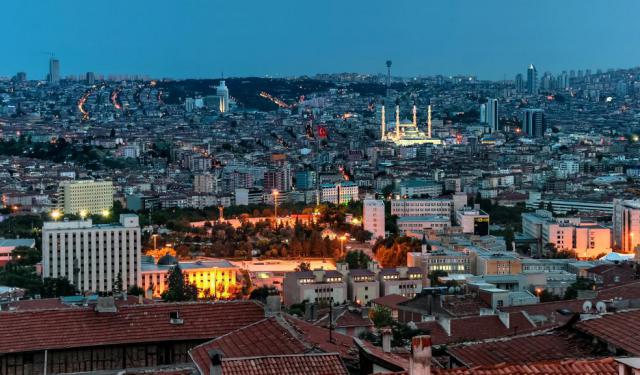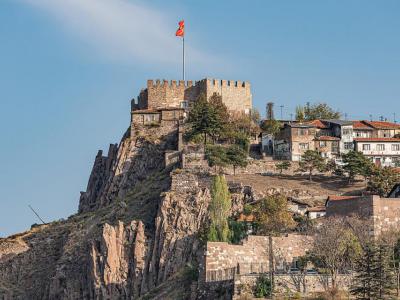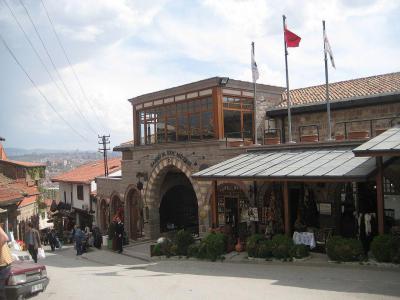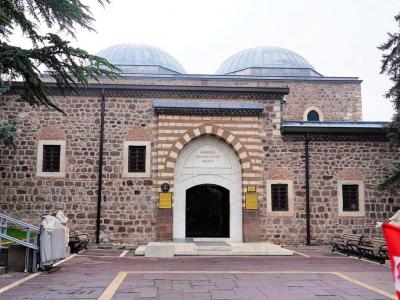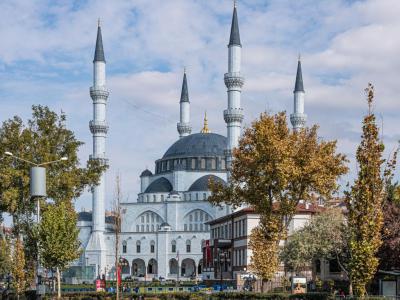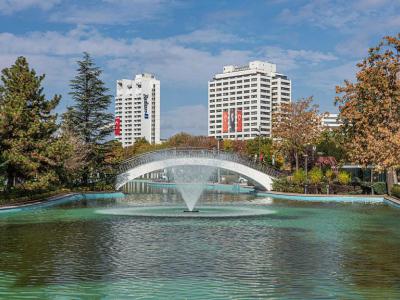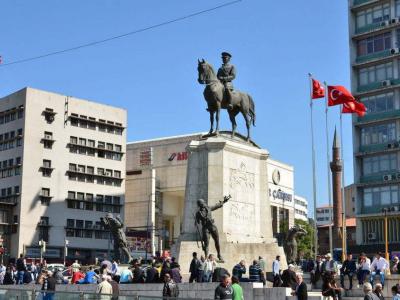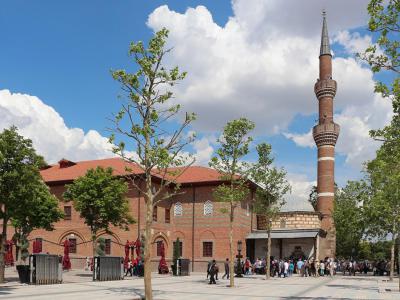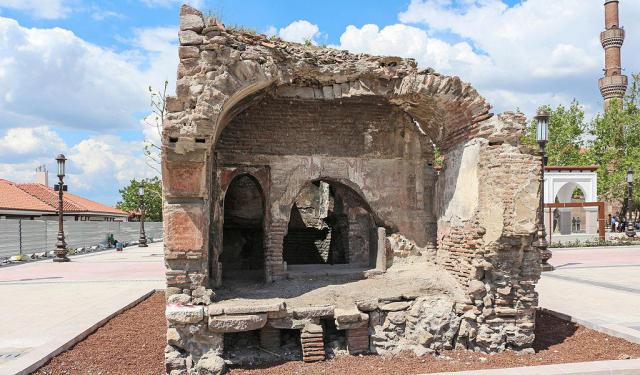Ankara Introduction Walking Tour (Self Guided), Ankara
Ankara, the capital of modern Turkey, is the heart of the country's central region of Anatolia. Apart from being an important center for politics, this cosmopolitan city – the second-largest in Turkey after Istanbul – plays a significant role in shaping the nation's cultural and economic landscape.
Ankara has a long and eventful history, dating back to the Bronze Age, circa 2,000 BC. Owing to its strategic position at the center of the Anatolian tableland, as a key stopping-place en route from Persia to the Aegean coast, over the centuries, the city has been contested by various civilizations, including the Hittites, Phrygians, Lydians, Persians, Greeks, Romans, Byzantines, Seljuks, and Ottomans.
One of the most ancient local landmarks is the prominent Ankara Citadel, sitting atop a hill overlooking the city; it was built around the 7th century on the site of an earlier fortification constructed in the 8th century BC.
The name Ankara is believed to have originated from the Greek word 'Ancyra', which means anchor. Some sources suggest that the city was named after the anchor-shaped hill on which it was built.
Ankara played a significant role during the Turkish War of Independence and became the capital of the new Turkish Republic in 1923. A testament to that period is the Victory Monument erected at Ulus Square.
The city is home to several museums, including the Museum of Anatolian Civilizations and the Çengelhan Rahmi M. Koç Museum, which is an industrial technology museum situated in a 16th-century Ottoman-era inn.
Similarly to her grander sister Istanbul, Ankara is "a city of contrasts" with a rather diverse and multifaceted nature, featuring a mix of modern and traditional elements, both urban and rural, and of different cultural and ethnic origins. For more in-depth exposure to the wealth of experiences Ankara has to offer, you may wish to embark on a self-guided walking tour armed with this mobile app.
Ankara has a long and eventful history, dating back to the Bronze Age, circa 2,000 BC. Owing to its strategic position at the center of the Anatolian tableland, as a key stopping-place en route from Persia to the Aegean coast, over the centuries, the city has been contested by various civilizations, including the Hittites, Phrygians, Lydians, Persians, Greeks, Romans, Byzantines, Seljuks, and Ottomans.
One of the most ancient local landmarks is the prominent Ankara Citadel, sitting atop a hill overlooking the city; it was built around the 7th century on the site of an earlier fortification constructed in the 8th century BC.
The name Ankara is believed to have originated from the Greek word 'Ancyra', which means anchor. Some sources suggest that the city was named after the anchor-shaped hill on which it was built.
Ankara played a significant role during the Turkish War of Independence and became the capital of the new Turkish Republic in 1923. A testament to that period is the Victory Monument erected at Ulus Square.
The city is home to several museums, including the Museum of Anatolian Civilizations and the Çengelhan Rahmi M. Koç Museum, which is an industrial technology museum situated in a 16th-century Ottoman-era inn.
Similarly to her grander sister Istanbul, Ankara is "a city of contrasts" with a rather diverse and multifaceted nature, featuring a mix of modern and traditional elements, both urban and rural, and of different cultural and ethnic origins. For more in-depth exposure to the wealth of experiences Ankara has to offer, you may wish to embark on a self-guided walking tour armed with this mobile app.
How it works: Download the app "GPSmyCity: Walks in 1K+ Cities" from Apple App Store or Google Play Store to your mobile phone or tablet. The app turns your mobile device into a personal tour guide and its built-in GPS navigation functions guide you from one tour stop to next. The app works offline, so no data plan is needed when traveling abroad.
Ankara Introduction Walking Tour Map
Guide Name: Ankara Introduction Walking Tour
Guide Location: Turkey » Ankara (See other walking tours in Ankara)
Guide Type: Self-guided Walking Tour (Sightseeing)
# of Attractions: 7
Tour Duration: 1 Hour(s)
Travel Distance: 2.6 Km or 1.6 Miles
Author: alexander
Sight(s) Featured in This Guide:
Guide Location: Turkey » Ankara (See other walking tours in Ankara)
Guide Type: Self-guided Walking Tour (Sightseeing)
# of Attractions: 7
Tour Duration: 1 Hour(s)
Travel Distance: 2.6 Km or 1.6 Miles
Author: alexander
Sight(s) Featured in This Guide:
- Ankara Citadel
- Çengelhan Rahmi M. Koç Museum
- The Museum of Anatolian Civilizations
- Melike Hatun Mosque
- Gençlik Park
- Ulus Square. Monument of Republic
- Hacı Bayram Mosque
1) Ankara Citadel (must see)
Ankara Citadel is a significant historical site in the city of Ankara. Its construction dates back to the 7th century or later, with the initial fortification built by the Phrygians in the 8th century BC and later reconstructed in 278 BC by the Galatians. Throughout the centuries, the fortress was renovated and rebuilt under the rule of the Roman, Byzantine, Seljuk, and Ottoman empires.
The fortress comprises an inner wall with closely spaced towers that encircle a central area, as well as an outer wall lined with towers. Both walls were constructed using repurposed masonry after the Persian capture and destruction of Ankara in 622 AD. The inner walls may have been built during Constans II's reign, while the outer walls were likely established slightly later.
The Citadel's current appearance is the result of restoration efforts in 1832, funded and managed by Ibrahim Pasha, the son of Ottoman Egypt's governor Mehmed Ali Pasha. During the restoration, fragments of Roman sarcophagi, Latin-inscribed marble slabs, and Roman structure column heads were incorporated into the castle's structure. Today, remnants of the Roman era can still be seen within the towering walls.
Ankara Citadel has become a popular tourist destination in the Turkish capital. Visitors can enjoy exploring the ancient castle walls, walking along cobblestone paths, visiting art studios and world-class museums, watching skilled street performers, relaxing in trendy cafes, and shopping in small stores offering a variety of products.
The fortress comprises an inner wall with closely spaced towers that encircle a central area, as well as an outer wall lined with towers. Both walls were constructed using repurposed masonry after the Persian capture and destruction of Ankara in 622 AD. The inner walls may have been built during Constans II's reign, while the outer walls were likely established slightly later.
The Citadel's current appearance is the result of restoration efforts in 1832, funded and managed by Ibrahim Pasha, the son of Ottoman Egypt's governor Mehmed Ali Pasha. During the restoration, fragments of Roman sarcophagi, Latin-inscribed marble slabs, and Roman structure column heads were incorporated into the castle's structure. Today, remnants of the Roman era can still be seen within the towering walls.
Ankara Citadel has become a popular tourist destination in the Turkish capital. Visitors can enjoy exploring the ancient castle walls, walking along cobblestone paths, visiting art studios and world-class museums, watching skilled street performers, relaxing in trendy cafes, and shopping in small stores offering a variety of products.
2) Çengelhan Rahmi M. Koç Museum (must see)
Çengelhan Rahmi M. Koç Museum is a technology museum located in the historic Atpazarı (Horse market) district of Ankara, facing the Ankara Citadel. Positioned at an altitude of 950 meters (3,120 feet), the museum is slightly elevated above the rest of the city.
The museum is housed within the Çengelhan, a historical inn (han) that was constructed in 1523 during the reign of Ottoman Sultan Suleyman I. Originally used as a warehouse for mohair, a specialty of Ankara, it was later owned by the General Directorate of Foundations of Turkey during the Republican era. In 2003, industrialist Rahmi M. Koç rented the building to be used as a museum, and after undergoing restoration, it opened its doors in 2005.
The ground floor of the museum exhibits various machines, road transport vehicles, medicine, and everyday life tools. Additionally, a carpet gallery, agricultural machinery, and pharmaceutical exhibits are located on the lower floor. A brasserie is also available on the ground floor for visitors. On the upper floor, visitors can explore sections dedicated to rail transport items, toys, communications, scientific instruments, maritime, and navigation. The museum also features sections highlighting the city of Ankara, Vehbi Koç, Rahmi Koç's father and one of Turkey's first industrialists, and Mustafa Kemal Atatürk, the founder of modern Turkey.
The museum is housed within the Çengelhan, a historical inn (han) that was constructed in 1523 during the reign of Ottoman Sultan Suleyman I. Originally used as a warehouse for mohair, a specialty of Ankara, it was later owned by the General Directorate of Foundations of Turkey during the Republican era. In 2003, industrialist Rahmi M. Koç rented the building to be used as a museum, and after undergoing restoration, it opened its doors in 2005.
The ground floor of the museum exhibits various machines, road transport vehicles, medicine, and everyday life tools. Additionally, a carpet gallery, agricultural machinery, and pharmaceutical exhibits are located on the lower floor. A brasserie is also available on the ground floor for visitors. On the upper floor, visitors can explore sections dedicated to rail transport items, toys, communications, scientific instruments, maritime, and navigation. The museum also features sections highlighting the city of Ankara, Vehbi Koç, Rahmi Koç's father and one of Turkey's first industrialists, and Mustafa Kemal Atatürk, the founder of modern Turkey.
3) The Museum of Anatolian Civilizations (must see)
The Museum of Anatolian Civilizations is situated on the southern side of Ankara Castle, in the Atpazarı region of Ankara. The museum is comprised of the ancient Ottoman Mahmut Paşa bazaar storage building and the Kurşunlu Han. Following renovations and repairs (1938-1968), the museum opened its doors to the public as the Ankara Archaeological Museum.
Nowadays, the Kurşunlu Han functions as an administrative building and contains workrooms, a library, a conference hall, a laboratory, and a workshop. The old bazaar building showcases the exhibits. Inside this Ottoman structure, the museum displays a variety of Anatolian archaeological artifacts, ranging from the Paleolithic period to the Ottoman era, in chronological order. The museum also features a vast collection of items unearthed from numerous excavation sites, representing multiple historical periods.
The showcased gold, silver, glass, marble, and bronze works date back to the latter half of the first millennium BC. The coin collections, which include examples from the first minted coins to contemporary times, are considered the museum's unique cultural treasures.
On April 19, 1997, the Museum of Anatolian Civilizations was recognized as the first "European Museum of the Year" in Switzerland, thanks to its historical buildings and deep-rooted past.
Nowadays, the Kurşunlu Han functions as an administrative building and contains workrooms, a library, a conference hall, a laboratory, and a workshop. The old bazaar building showcases the exhibits. Inside this Ottoman structure, the museum displays a variety of Anatolian archaeological artifacts, ranging from the Paleolithic period to the Ottoman era, in chronological order. The museum also features a vast collection of items unearthed from numerous excavation sites, representing multiple historical periods.
The showcased gold, silver, glass, marble, and bronze works date back to the latter half of the first millennium BC. The coin collections, which include examples from the first minted coins to contemporary times, are considered the museum's unique cultural treasures.
On April 19, 1997, the Museum of Anatolian Civilizations was recognized as the first "European Museum of the Year" in Switzerland, thanks to its historical buildings and deep-rooted past.
4) Melike Hatun Mosque
Melike Hatun Mosque is a modern mosque located in the old quarter of Ankara, known as Hergele Meydanı. It was opened to the public in 2017 and is named after Melike Hatun, a wealthy lady from the 14th century who was the commissioner of many public buildings in Ankara and a supporter of Haji Bayram Veli, an Ottoman poet, and Sufi saint.
The mosque is designed by architect Hilmi Şenalp and is known for its modern features and exhibition halls. It is situated east of Atatürk Boulevard and Gençlik Park, and within the mosque complex, there are a congress center, civilizations museum, meeting halls, and a five-story parking garage. The mosque has a ground area of 3,600 square meters (39,000 square feet) and can accommodate 7,000 prayers. It is a four-minaret mosque, with each minaret having three balconies, and the height of each minaret is 72 meters (236 feet).
The dome has a diameter of 27 meters (89 feet) and a maximum height of 47 meters (154 feet). The interior of the mosque is adorned with warm colors and detailed designs, and there are inscriptions made of gold leaf on the entrance doors. Melike Hatun Mosque is popular among locals and tourists alike due to its modern design and exhibition halls.
The mosque is designed by architect Hilmi Şenalp and is known for its modern features and exhibition halls. It is situated east of Atatürk Boulevard and Gençlik Park, and within the mosque complex, there are a congress center, civilizations museum, meeting halls, and a five-story parking garage. The mosque has a ground area of 3,600 square meters (39,000 square feet) and can accommodate 7,000 prayers. It is a four-minaret mosque, with each minaret having three balconies, and the height of each minaret is 72 meters (236 feet).
The dome has a diameter of 27 meters (89 feet) and a maximum height of 47 meters (154 feet). The interior of the mosque is adorned with warm colors and detailed designs, and there are inscriptions made of gold leaf on the entrance doors. Melike Hatun Mosque is popular among locals and tourists alike due to its modern design and exhibition halls.
5) Gençlik Park
Gençlik Park, also known as Youth Park, is a historical park located in Ankara. It covers an area of 27.5 hectares (68 acres) and has six different entrance gates. The park was constructed between 1936 and 1943 and is one of the first urban parks in Turkey. It underwent major repairs and renovations in 2007 and now offers various facilities for locals and tourists.
One of the favorite spots in the park is its amusement park, which offers various games and activities for people of all ages. The park also has benches by the lake, making it a popular spot for photography enthusiasts and those who enjoy spending time in nature.
In addition to its natural attractions, the park has several social facilities, including a theater building, a women's solidarity center, a tourism office, a wedding and wedding hall, culture and youth centers, and various tea gardens and restaurants. The Ankara Metropolitan Municipality Theater, located within the park, is one of the largest theaters in the city and hosts many theater groups throughout the year.
The Youth Center, located in the park, offers activities such as guitar, organ, baglama, foreign language, table tennis, billiards, and mini-golf for young people. There is also a cultural center in the park that hosts various cultural events. With its diverse attractions and facilities, Gençlik Park is a popular destination for locals and tourists in Ankara.
One of the favorite spots in the park is its amusement park, which offers various games and activities for people of all ages. The park also has benches by the lake, making it a popular spot for photography enthusiasts and those who enjoy spending time in nature.
In addition to its natural attractions, the park has several social facilities, including a theater building, a women's solidarity center, a tourism office, a wedding and wedding hall, culture and youth centers, and various tea gardens and restaurants. The Ankara Metropolitan Municipality Theater, located within the park, is one of the largest theaters in the city and hosts many theater groups throughout the year.
The Youth Center, located in the park, offers activities such as guitar, organ, baglama, foreign language, table tennis, billiards, and mini-golf for young people. There is also a cultural center in the park that hosts various cultural events. With its diverse attractions and facilities, Gençlik Park is a popular destination for locals and tourists in Ankara.
6) Ulus Square. Monument of Republic
Ulus Square is a historic square in Ankara, known for its significance to the Turkish nation. The square is located at the intersection of four streets, including Atatürk Boulevard, which runs to the south, and Çankırı Street, which continues north from Atatürk Boulevard. The square's name, "Ulus," translates to "nation" in Turkish, and it is an important gathering place for locals and tourists alike.
The centerpiece of Ulus Square is a memorial called Victory Monument, also known as the Monument of Republic, designed by Austrian sculptor Heinrich Krippel. The Victory Monument was a result of a nationwide fund drive organized by journalist Yunus Nadi. Heinrich Krippel's design won an international competition, and the monument was inaugurated on 24 November 1927.
The Victory Monument is a group of bronze statues, including an equestrian Atatürk in the center flanked by two soldiers and a woman. One soldier is depicted calling his friend to the battlefront, while the other is shown observing the front. The woman is carrying a cannonball, representing the contributions of Turkish women during the Turkish War of Independence. The monument, restored in 2002, continues to be an important landmark and gathering place in Ankara.
The centerpiece of Ulus Square is a memorial called Victory Monument, also known as the Monument of Republic, designed by Austrian sculptor Heinrich Krippel. The Victory Monument was a result of a nationwide fund drive organized by journalist Yunus Nadi. Heinrich Krippel's design won an international competition, and the monument was inaugurated on 24 November 1927.
The Victory Monument is a group of bronze statues, including an equestrian Atatürk in the center flanked by two soldiers and a woman. One soldier is depicted calling his friend to the battlefront, while the other is shown observing the front. The woman is carrying a cannonball, representing the contributions of Turkish women during the Turkish War of Independence. The monument, restored in 2002, continues to be an important landmark and gathering place in Ankara.
7) Hacı Bayram Mosque (must see)
Located near the Ulus District in Ankara, adjacent to the Augustus Temple, the Haci Bayram Mosque was originally constructed in 1427 to honor the Turkish poet, mystic, and founder of the Bayrami Sufi order, Hacı Bayram Veli. The mosque's present architecture is a combination of late 17th and 18th-century styles, with later additions in the north and west.
The rectangularly planned mosque has a two-gallery minaret with a square base and brick frame located on the southeast side of the mausoleum. An inscription in large Arabic calligraphy, reading "In the Name of God, The Most Gracious, The Most Merciful," adorns the southern wall. The central hexagonal rosette is surrounded by six rows of floral decorations. A smaller version of this rosette can be found in the rectangular panel on the annexed section's ceiling to the west.
The mosque's lower-level windows have wrought-iron grates and are rectangular, while the exterior windows have niches comprised of pointed arches. The upper windows feature stained glass bordered by chiseled marble motifs and pointed arches. The Mihrab, indicating the direction of Mecca for prayer, is decorated with a cross-section of stalactites, while the corners feature an elegant inscription from the Koran in five rows on the pediment. The borders of the Mihrab also feature the Koran.
The Haci Bayram Mosque was added to the tentative list of UNESCO World Heritage Sites in Turkey in 2016.
The rectangularly planned mosque has a two-gallery minaret with a square base and brick frame located on the southeast side of the mausoleum. An inscription in large Arabic calligraphy, reading "In the Name of God, The Most Gracious, The Most Merciful," adorns the southern wall. The central hexagonal rosette is surrounded by six rows of floral decorations. A smaller version of this rosette can be found in the rectangular panel on the annexed section's ceiling to the west.
The mosque's lower-level windows have wrought-iron grates and are rectangular, while the exterior windows have niches comprised of pointed arches. The upper windows feature stained glass bordered by chiseled marble motifs and pointed arches. The Mihrab, indicating the direction of Mecca for prayer, is decorated with a cross-section of stalactites, while the corners feature an elegant inscription from the Koran in five rows on the pediment. The borders of the Mihrab also feature the Koran.
The Haci Bayram Mosque was added to the tentative list of UNESCO World Heritage Sites in Turkey in 2016.
Walking Tours in Ankara, Turkey
Create Your Own Walk in Ankara
Creating your own self-guided walk in Ankara is easy and fun. Choose the city attractions that you want to see and a walk route map will be created just for you. You can even set your hotel as the start point of the walk.
Ankara Roman Ruins Walking Tour
In 25 BC, Emperor Augustus annexed Ankara, then known as Ancyra, to the Roman Empire. Following that, the city, attached with considerable importance, was enhanced with fortifications and embellished with temples and elaborate civic buildings.
The most significant Roman landmarks, a testament to the Roman imperial cultural influence, survived to our days albeit ruined, include the Roman Theater... view more
Tour Duration: 1 Hour(s)
Travel Distance: 1.4 Km or 0.9 Miles
The most significant Roman landmarks, a testament to the Roman imperial cultural influence, survived to our days albeit ruined, include the Roman Theater... view more
Tour Duration: 1 Hour(s)
Travel Distance: 1.4 Km or 0.9 Miles
The Most Popular Cities
/ view all
